本笔记内容为狂神说JUC并发编程部分
目录
一、什么是JUC
JUC是Java Util Concurrent的缩写,是Java SE 5.0中新增的一个包,主要提供了在并发编程中使用的工具类和框架。JUC包含了许多用于多线程编程的工具类和接口,如锁、原子变量、线程池、阻塞队列等。这些工具类和接口可以帮助开发者更方便地进行多线程编程,从而提高程序的并发性能和可靠性。
JUC包中的工具类和接口都是线程安全的,可以在多线程环境下安全地使用。它们的设计和实现都是基于并发编程的最佳实践和原则,可以有效地避免线程安全问题的发生。
JUC包中的一些重要的类和接口包括:Lock、ReentrantLock、Condition、Semaphore、CountDownLatch、CyclicBarrier、AtomicInteger、ThreadPoolExecutor、BlockingQueue等。这些类和接口的使用可以极大地简化多线程编程的复杂度,提高程序的可读性和可维护性。

回顾
业务:普通的线程代码 Thread
Runnable 没有返回值、效率相比入 Callable 相对较低!


二、线程和进程
1、概述
线程和进程是操作系统中的两个基本概念。
进程是程序在操作系统中的一次执行过程,它是操作系统资源分配的基本单位。每个进程都有自己的地址空间、数据栈、代码段和堆栈,不同进程之间的数据是独立的。进程之间通信需要使用进程间通信(IPC)机制,如管道、信号量、消息队列等。
线程是进程中的一个执行单元,是CPU调度的基本单位。一个进程可以包含多个线程,同一进程中的不同线程共享进程的地址空间、数据栈和代码段,但每个线程都有自己的堆栈。线程之间的通信可以通过共享内存或者消息传递来实现,相比进程间通信,线程间通信的开销更小。
总的来说,进程是系统资源分配的基本单位,而线程是CPU调度的基本单位。进程之间相互独立,线程之间共享进程的资源。多线程可以提高程序的并发性能,但也需要注意线程安全问题。
进程:一个程序,QQ.exe Music.exe 程序的集合
一个进程往往可以包含多个线程,至少包含一个!
线程:开了一个进程 Typora,写字,自动保存(线程负责的)
对于Java而言:Thread、Runnable、Callable
Java默认有几个线程?2 个 mian、GC
Java 真的可以开启线程吗? 开不了,进入Thread的start()可以看到调用的是native方法

2、并发、并行
并发编程:并发、并行
并发(多线程操作同一个资源)
- CPU 一核 ,模拟出来多条线程,天下武功,唯快不破,快速交替
并行(多个人一起行走)
- CPU 多核 ,多个线程可以同时执行; 线程池
public class Test1 {
public static void main(String[] args) {
// 获取cpu的核数
// CPU 密集型,IO密集型
System.out.println(Runtime.getRuntime().availableProcessors());
}
}并发编程的本质:充分利用CPU的资源
3、线程有几个状态
public enum State {
// 新生
NEW,
// 运行
RUNNABLE,
// 阻塞
BLOCKED,
// 等待,死死地等
WAITING,
// 超时等待
TIMED_WAITING,
// 终止
TERMINATED;
}4、wait/sleep 区别
1.来自不同的类
- wait => Object
- sleep => Thread
2.关于锁的释放
- wait 会释放锁
- sleep不会释放!
3.使用的范围是不同的
- wait要写在同步代码块中
- sleep 可以再任何地方睡
4.是否需要捕获异常
- wait 不需要捕获异常
- sleep 必须要捕获异常
三、Lock锁(重点)
传统 Synchronized
// 基本的卖票例子
import java.time.OffsetDateTime;
/**
* 真正的多线程开发,公司中的开发,降低耦合性
* 线程就是一个单独的资源类,没有任何附属的操作!
* 1、 属性、方法
*/
public class SaleTicketDemo01 {
public static void main(String[] args) {
// 并发:多线程操作同一个资源类, 把资源类丢入线程
Ticket ticket = new Ticket();
// @FunctionalInterface 函数式接口,jdk1.8 lambda表达式 (参数)->{ 代码 }
new Thread(()->{
for (int i = 1; i < 40 ; i++) {
ticket.sale();
}
},"A").start();
new Thread(()->{
for (int i = 1; i < 40 ; i++) {
ticket.sale();
}
},"B").start();
new Thread(()->{
for (int i = 1; i < 40 ; i++) {
ticket.sale();
}
},"C").start();
}
}
// 资源类 OOP
class Ticket {
// 属性、方法
private int number = 30;
// 卖票的方式
// synchronized 本质: 队列,锁
public synchronized void sale(){
if (number>0){
System.out.println(Thread.currentThread().getName()+"卖出了"+(number-
-)+"票,剩余:"+number);
}
}
}Lock 接口



公平锁:十分公平:可以先来后到
非公平锁:十分不公平:可以插队 (默认)
import java.util.concurrent.locks.Lock;
import java.util.concurrent.locks.ReentrantLock;
public class SaleTicketDemo02 {
public static void main(String[] args) {
// 并发:多线程操作同一个资源类, 把资源类丢入线程
Ticket2 ticket = new Ticket2();
// @FunctionalInterface 函数式接口,jdk1.8 lambda表达式 (参数)->{ 代码 }
new Thread(()->{for (int i = 1; i < 40 ; i++)
ticket.sale();},"A").start();
new Thread(()->{for (int i = 1; i < 40 ; i++)
ticket.sale();},"B").start();
new Thread(()->{for (int i = 1; i < 40 ; i++)
ticket.sale();},"C").start();
}
}
// Lock三部曲
// 1、 new ReentrantLock();
// 2、 lock.lock(); // 加锁
// 3、 finally=> lock.unlock(); // 解锁
class Ticket2 {
// 属性、方法
private int number = 30;
Lock lock = new ReentrantLock();
public void sale(){
lock.lock(); // 加锁
try {
// 业务代码
if (number>0){
System.out.println(Thread.currentThread().getName()+"卖出了"+
(number--)+"票,剩余:"+number);
}
} catch (Exception e) {
e.printStackTrace();
} finally {
lock.unlock(); // 解锁
}
}
}Synchronized 和 Lock 区别
- Synchronized 内置的Java关键字, Lock 是一个Java类
- Synchronized 无法判断获取锁的状态,Lock 可以判断是否获取到了锁
- Synchronized 会自动释放锁,lock 必须要手动释放锁!如果不释放锁,死锁
- Synchronized 线程 1(获得锁,阻塞)、线程2(等待,傻傻的等);Lock锁就不一定会等待下去;
- Synchronized 可重入锁,不可以中断的,非公平;Lock ,可重入锁,可以 判断锁,非公平(可以自己设置);
- Synchronized 适合锁少量的代码同步问题,Lock 适合锁大量的同步代码!
四、生产者和消费者问题
面试的:单例模式、排序算法、生产者和消费者、死锁
生产者和消费者问题 Synchronized 版
/**
* 线程之间的通信问题:生产者和消费者问题! 等待唤醒,通知唤醒
* 线程交替执行 A B 操作同一个变量 num = 0
* A num+1
* B num-1
*/
public class A {
public static void main(String[] args) {
Data data = new Data();
new Thread(()->{
for (int i = 0; i < 10; i++) {
try {
data.increment();
} catch (InterruptedException e) {
e.printStackTrace();
}
}
},"A").start();
new Thread(()->{
for (int i = 0; i < 10; i++) {
try {
data.decrement();
} catch (InterruptedException e) {
e.printStackTrace();
}
}
},"B").start();
}
}
// 判断等待,业务,通知
class Data{ // 数字 资源类
private int number = 0;
//+1
public synchronized void increment() throws InterruptedException {
if (number!=0){ //0
// 等待
this.wait();
}
number++;
System.out.println(Thread.currentThread().getName()+"=>"+number);
// 通知其他线程,我+1完毕了
this.notifyAll();
}
//-1
public synchronized void decrement() throws InterruptedException {
if (number==0){ // 1
// 等待
this.wait();
}
number--;
System.out.println(Thread.currentThread().getName()+"=>"+number);
// 通知其他线程,我-1完毕了
this.notifyAll();
}
}问题存在,A B C D 4 个线程!虚假唤醒
假唤醒(spurious wakeup)是指在多线程编程中,线程在等某个条件时,即使没有其他线程通知或者中断它,它也会被唤醒。这种唤醒是不可预测的,因为它不是由其他线程发出的信号或者中断所引起的,也就是说,它是“虚假”的。

if 改为 while 判断

JUC版的生产者和消费者问题

通过Lock 找到 Condition

代码实现:
import java.util.concurrent.locks.Condition;
import java.util.concurrent.locks.Lock;
import java.util.concurrent.locks.ReentrantLock;
public class B {
public static void main(String[] args) {
Data2 data = new Data2();
new Thread(()->{
for (int i = 0; i < 10; i++) {
try {
data.increment();
} catch (InterruptedException e) {
e.printStackTrace();
}
}
},"A").start();
new Thread(()->{
for (int i = 0; i < 10; i++) {
try {
data.decrement();
} catch (InterruptedException e) {
e.printStackTrace();
}
}
},"B").start();
new Thread(()->{
for (int i = 0; i < 10; i++) {
try {
data.increment();
} catch (InterruptedException e) {
e.printStackTrace();
}
}
},"C").start();
new Thread(()->{
for (int i = 0; i < 10; i++) {
try {
data.decrement();
} catch (InterruptedException e) {
e.printStackTrace();
}
}
},"D").start();
}
}
// 判断等待,业务,通知
class Data2{ // 数字 资源类
private int number = 0;
Lock lock = new ReentrantLock();
Condition condition = lock.newCondition();
//condition.await(); // 等待
//condition.signalAll(); // 唤醒全部
//+1
public void increment() throws InterruptedException {
任何一个新的技术,绝对不是仅仅只是覆盖了原来的技术,优势和补充!
Condition 精准的通知和唤醒线程
lock.lock();
try {
// 业务代码
while (number!=0){ //0
// 等待
condition.await();
}
number++;
System.out.println(Thread.currentThread().getName()+"=>"+number);
// 通知其他线程,我+1完毕了
condition.signalAll();
} catch (Exception e) {
e.printStackTrace();
} finally {
lock.unlock();
}
}
//-1
public synchronized void decrement() throws InterruptedException {
lock.lock();
try {
while (number==0){ // 1
// 等待
condition.await();
}
number--;
System.out.println(Thread.currentThread().getName()+"=>"+number);
// 通知其他线程,我-1完毕了
condition.signalAll();
} catch (Exception e) {
e.printStackTrace();
} finally {
lock.unlock();
}
}
}任何一个新的技术,绝对不是仅仅只是覆盖了原来的技术,优势和补充!
Condition 精准的通知和唤醒线程

import java.util.concurrent.locks.Condition;
import java.util.concurrent.locks.Lock;
import java.util.concurrent.locks.ReentrantLock;
/**
* @author 狂神说Java 24736743@qq.com
* A 执行完调用B,B执行完调用C,C执行完调用A
* 创建多个监视器来监视不同的方法条件
*/
public class C {
public static void main(String[] args) {
Data3 data = new Data3();
new Thread(()->{
for (int i = 0; i <10 ; i++) {
data.printA();
}
},"A").start();
new Thread(()->{
for (int i = 0; i <10 ; i++) {
data.printB();
}
},"B").start();
new Thread(()->{
for (int i = 0; i <10 ; i++) {
data.printC();
}
},"C").start();
}
}
class Data3{ // 资源类 Lock
private Lock lock = new ReentrantLock();
private Condition condition1 = lock.newCondition();
private Condition condition2 = lock.newCondition();
private Condition condition3 = lock.newCondition();
private int number = 1; // 1A 2B 3C
public void printA(){
lock.lock();
try {
// 业务,判断-> 执行-> 通知
while (number!=1){
// 等待
condition1.await();
}
System.out.println(Thread.currentThread().getName()+"=>AAAAAAA");
// 唤醒,唤醒指定的人,B
number = 2;
condition2.signal();
} catch (Exception e) {
e.printStackTrace();
} finally {
lock.unlock();
}
}
public void printB(){
lock.lock();
try {
// 业务,判断-> 执行-> 通知
while (number!=2){
condition2.await();
}
System.out.println(Thread.currentThread().getName()+"=>BBBBBBBBB");
// 唤醒,唤醒指定的人,c
number = 3;
condition3.signal();
} catch (Exception e) {
e.printStackTrace();
} finally {
lock.unlock();
}
}
public void printC(){
lock.lock();
try {
// 业务,判断-> 执行-> 通知
// 业务,判断-> 执行-> 通知
while (number!=3){
condition3.await();
}
System.out.println(Thread.currentThread().getName()+"=>BBBBBBBBB");
// 唤醒,唤醒指定的人,c
number = 1;
condition1.signal();
} catch (Exception e) {
e.printStackTrace();
} finally {
lock.unlock();
}
}
}五、八锁现象
如何判断锁的是谁!永远的知道什么锁,锁到底锁的是谁!
八锁现象是Java中多线程编程中的一个经典案例,用来说明多线程的并发问题。
八锁现象的实质是多个线程竞争同一资源时,不同的锁会导致线程的执行顺序不同,从而导致程序出现不同的结果。在多线程编程中,需要注意锁的使用,避免出现死锁、饥饿等问题。
synchronized 锁的对象是方法的调用者!
两个方法用的是同一个锁,谁先拿到谁执行!
import java.util.concurrent.TimeUnit;
/**
* 8锁,就是关于锁的8个问题
* 1、标准情况下,两个线程先打印 发短信还是 打电话? 1/发短信 2/打电话
* 1、sendSms延迟4秒,两个线程先打印 发短信还是 打电话? 1/发短信 2/打电话
*/
public class Test1 {
public static void main(String[] args) {
Phone phone = new Phone();
//锁的存在
new Thread(()->{
phone.sendSms();
},"A").start();
// 捕获
try {
TimeUnit.SECONDS.sleep(1);
} catch (InterruptedException e) {
e.printStackTrace();
}
new Thread(()->{
phone.call();
},"B").start();
}
}
class Phone{
// synchronized 锁的对象是方法的调用者!、
// 两个方法用的是同一个锁,谁先拿到谁执行!
public synchronized void sendSms(){
try {
TimeUnit.SECONDS.sleep(4);
} catch (InterruptedException e) {
e.printStackTrace();
}
System.out.println("发短信");
}
public synchronized void call(){
System.out.println("打电话");
}
}两个对象,两个调用者,两把锁!
import java.util.concurrent.TimeUnit;
/**
* 3、 增加了一个普通方法后!先执行发短信还是Hello? 普通方法
* 4、 两个对象,两个同步方法, 发短信还是 打电话? // 打电话
*/
public class Test2 {
public static void main(String[] args) {
// 两个对象,两个调用者,两把锁!
Phone2 phone1 = new Phone2();
Phone2 phone2 = new Phone2();
//锁的存在
new Thread(()->{
phone1.sendSms();
},"A").start();
// 捕获
try {
TimeUnit.SECONDS.sleep(1);
} catch (InterruptedException e) {
e.printStackTrace();
}
new Thread(()->{
phone2.call();
},"B").start();
}
}
class Phone2{
// synchronized 锁的对象是方法的调用者!
public synchronized void sendSms(){
try {
TimeUnit.SECONDS.sleep(4);
} catch (InterruptedException e) {
e.printStackTrace();
}
System.out.println("发短信");
}
public synchronized void call(){
System.out.println("打电话");
}
// 这里没有锁!不是同步方法,不受锁的影响
public void hello(){
System.out.println("hello");
}
}两个对象的Class类模板只有一个,static,锁的是Class
import java.util.concurrent.TimeUnit;
/**
* 5、增加两个静态的同步方法,只有一个对象,先打印 发短信?打电话?
* 6、两个对象!增加两个静态的同步方法, 先打印 发短信?打电话?
*/
public class Test3 {
public static void main(String[] args) {
// 两个对象的Class类模板只有一个,static,锁的是Class
Phone3 phone1 = new Phone3();
Phone3 phone2 = new Phone3();
//锁的存在
new Thread(()->{
phone1.sendSms();
},"A").start();
// 捕获
try {
TimeUnit.SECONDS.sleep(1);
} catch (InterruptedException e) {
e.printStackTrace();
}
new Thread(()->{
phone2.call();
},"B").start();
}
}
// Phone3唯一的一个 Class 对象
class Phone3{
// synchronized 锁的对象是方法的调用者!
// static 静态方法
// 类一加载就有了!锁的是Class
public static synchronized void sendSms(){
try {
TimeUnit.SECONDS.sleep(4);
} catch (InterruptedException e) {
e.printStackTrace();
}
System.out.println("发短信");
}
public static synchronized void call(){
System.out.println("打电话");
}
}-
import java.util.concurrent.TimeUnit;
/**
* 1、1个静态的同步方法,1个普通的同步方法 ,一个对象,先打印 发短信?打电话?
* 2、1个静态的同步方法,1个普通的同步方法 ,两个对象,先打印 发短信?打电话?
*/
public class Test4 {
public static void main(String[] args) {
// 两个对象的Class类模板只有一个,static,锁的是Class
Phone4 phone1 = new Phone4();
Phone4 phone2 = new Phone4();
//锁的存在
new Thread(()->{
phone1.sendSms();
},"A").start();
// 捕获
try {
TimeUnit.SECONDS.sleep(1);
} catch (InterruptedException e) {
e.printStackTrace();
}
new Thread(()->{
phone2.call();
},"B").start();
}
}
// Phone3唯一的一个 Class 对象
class Phone4{
// 静态的同步方法 锁的是 Class 类模板
public static synchronized void sendSms(){
try {
TimeUnit.SECONDS.sleep(4);
} catch (InterruptedException e) {
e.printStackTrace();
}
System.out.println("发短信");
}
// 普通的同步方法 锁的调用者
public synchronized void call(){
System.out.println("打电话");
}
}小结:new this 具体的一个手机,static Class 唯一的一个模板
六、集合类不安全
List 不安全
使用ArrayList运行以下代码会出现java.util.ConcurrentModificationException 并发修改异常!
解决方案:
- List<String> list = new Vector<>();
- List<String> list = Collections.synchronizedList(new ArrayList<>());
- List<String> list = new CopyOnWriteArrayList<>();
CopyOnWrite是Java中一种并发编程技术,它通过在写操作时复制一份数据,而不是直接修改原始数据来实现并发安全。CopyOnWrite的实现方式是在写操作时,先复制一份原始数据,对复制后的数据进行修改,修改完成后再将原始数据替换为新的数据。
import java.util.*;
import java.util.concurrent.CopyOnWriteArrayList;
// java.util.ConcurrentModificationException 并发修改异常!
public class ListTest {
public static void main(String[] args) {
// 并发下 ArrayList 不安全的吗,Synchronized;
/**
* 解决方案;
* 1、List<String> list = new Vector<>();
* 2、List<String> list = Collections.synchronizedList(new ArrayList<>
());
* 3、List<String> list = new CopyOnWriteArrayList<>();
*/
// CopyOnWrite 写入时复制 COW 计算机程序设计领域的一种优化策略;
// 多个线程调用的时候,list,读取的时候,固定的,写入(覆盖)
// 在写入的时候避免覆盖,造成数据问题!
// 读写分离
// CopyOnWriteArrayList 比 Vector Nb 在哪里?
List<String> list = new CopyOnWriteArrayList<>();
for (int i = 1; i <= 10; i++) {
new Thread(()->{
list.add(UUID.randomUUID().toString().substring(0,5));
System.out.println(list);
},String.valueOf(i)).start();
}
}
}Set 不安全
同样的问题使用Set<String> set = new HashSet<>(),会出现ConcurrentModificationException并发修改异常
解决方案:
- Set<String> set = Collections.synchronizedSet(new HashSet<>());
- Set<String> set = new CopyOnWriteArraySet<>();
import java.util.Collections;
import java.util.HashSet;
import java.util.Set;
import java.util.UUID;
import java.util.concurrent.CopyOnWriteArraySet;
/**
* 同理可证 : ConcurrentModificationException
* //1、Set<String> set = Collections.synchronizedSet(new HashSet<>());
* //2、
*/
public class SetTest {
public static void main(String[] args) {
// Set<String> set = new HashSet<>();
// Set<String> set = Collections.synchronizedSet(new HashSet<>());
Set<String> set = new CopyOnWriteArraySet<>();
for (int i = 1; i <=30 ; i++) {
new Thread(()->{
set.add(UUID.randomUUID().toString().substring(0,5));
System.out.println(set);
},String.valueOf(i)).start();
}
}
}hashSet 底层是什么?
当向HashSet中添加元素时,HashSet会将元素作为HashMap的键添加到HashMap中,如果该键已经存在,则不会添加,保证了HashSet中的元素不重复。HashSet的查询、插入和删除操作都是O(1)的时间复杂度,因此它是一种高效的集合实现方式。
public HashSet() {
map = new HashMap<>();
}
// add set 本质就是 map key是无法重复的!
public boolean add(E e) {
return map.put(e, PRESENT) == null;
}
private static final Object PRESENT = new Object(); // 不变得值!Map 不安全
回顾Map基本操作(默认加载因子0.75,初始容量16)

同样的问题使用HashMap会出现 ConcurrentModificationException 并发修改异常
解决方案:
- Map<String, String> map = Collections.synchronizedMap(new HashMap<>());
-
Map<String, String> map = new ConcurrentHashMap<>();
import java.util.Collections;
import java.util.HashMap;
import java.util.Map;
import java.util.UUID;
import java.util.concurrent.ConcurrentHashMap;
// ConcurrentModificationException
public class MapTest {
public static void main(String[] args) {
// map 是这样用的吗? 不是,工作中不用 HashMap
// 默认等价于什么? new HashMap<>(16,0.75);
// Map<String, String> map = new HashMap<>();
// 唯一的一个家庭作业:研究ConcurrentHashMap的原理
Map<String, String> map = new ConcurrentHashMap<>();
for (int i = 1; i <=30; i++) {
new Thread(()->{
map.put(Thread.currentThread().getName(),UUID.randomUUID().toString().substring(
0,5));
System.out.println(map);
},String.valueOf(i)).start();
}
}
}七、Callable ( 简单 )

相较于Runnable:
- 可以有返回值
- 可以抛出异常
- 方法不同,run()/ call()
代码测试


细节:
1、有缓存
2、结果可能需要等待,会阻塞!
import java.util.concurrent.Callable;
import java.util.concurrent.ExecutionException;
import java.util.concurrent.FutureTask;
import java.util.concurrent.locks.ReentrantLock;
/**
* 1、探究原理
* 2、觉自己会用
*/
public class CallableTest {
public static void main(String[] args) throws ExecutionException,
InterruptedException {
// new Thread(new Runnable()).start();
// new Thread(new FutureTask<V>()).start();
// new Thread(new FutureTask<V>( Callable )).start();
new Thread().start(); // 怎么启动Callable
MyThread thread = new MyThread();
FutureTask futureTask = new FutureTask(thread); // 适配类
new Thread(futureTask,"A").start();
new Thread(futureTask,"B").start(); // 结果会被缓存,效率高
Integer o = (Integer) futureTask.get(); //这个get 方法可能会产生阻塞!把他放到最后
// 或者使用异步通信来处理!
System.out.println(o);
}
}
class MyThread implements Callable<Integer> {
@Override
public Integer call() {
System.out.println("call()"); // 会打印几个call
// 耗时的操作
return 1024;
}
}
此时FutrueTask的state此时已非new状态,这个并不是缓存,是由于JVM第二次再调用FutrueTask对象所持有的线程则此时会直接结束对应线程,就会导致任务也不执行,只是在第一次调用时返回结果保存了,可能这就是老师所说的缓存
八、常用的辅助类(必会)
1、CountDownLatch

import java.util.concurrent.CountDownLatch;
// 计数器
public class CountDownLatchDemo {
public static void main(String[] args) throws InterruptedException {
// 总数是6,必须要执行任务的时候,再使用!
CountDownLatch countDownLatch = new CountDownLatch(6);
for (int i = 1; i <=6 ; i++) {
new Thread(()->{
System.out.println(Thread.currentThread().getName()+" Go out");
countDownLatch.countDown(); // 数量-1
},String.valueOf(i)).start();
}
countDownLatch.await(); // 等待计数器归零,然后再向下执行
System.out.println("Close Door");
}
}原理:
- countDownLatch.countDown(); // 数量-1
- countDownLatch.await(); // 等待计数器归零,然后再向下执行
每次有线程调用 countDown() 数量-1,假设计数器变为0,countDownLatch.await() 就会被唤醒,继续执行!
2、CyclicBarrier
CyclicBarrier的构造函数可以传入一个整数n,表示需要等待的线程数,以及一个Runnable对象,表示所有线程都到达屏障点时需要执行的操作。CyclicBarrier有一个await()方法,当线程调用该方法时,它会等待其他线程都到达屏障点,然后继续执行。CyclicBarrier还有一个reset()方法,可以重置屏障点,使得CyclicBarrier可以被重复使用。

加法计数器
import java.util.concurrent.BrokenBarrierException;
import java.util.concurrent.CyclicBarrier;
public class CyclicBarrierDemo {
public static void main(String[] args) {
/**
* 集齐7颗龙珠召唤神龙
*/
// 召唤龙珠的线程
CyclicBarrier cyclicBarrier = new CyclicBarrier(7,()->{
System.out.println("召唤神龙成功!");
});
for (int i = 1; i <=7 ; i++) {
final int temp = i;
// lambda能操作到 i 吗
new Thread(()->{
System.out.println(Thread.currentThread().getName()+"收
集"+temp+"个龙珠");
try {
cyclicBarrier.await(); // 等待
} catch (InterruptedException e) {
e.printStackTrace();
} catch (BrokenBarrierException e) {
e.printStackTrace();
}
}).start();
}
}
}3、Semaphore
Semaphore:信号量

抢车位:6车---3个停车位置
import java.util.concurrent.Semaphore;
import java.util.concurrent.TimeUnit;
public class SemaphoreDemo {
public static void main(String[] args) {
// 线程数量:停车位! 限流!
Semaphore semaphore = new Semaphore(3);
for (int i = 1; i <=6 ; i++) {
new Thread(()->{
// acquire() 得到
try {
semaphore.acquire();
System.out.println(Thread.currentThread().getName()+"抢到车
位");
TimeUnit.SECONDS.sleep(2);
System.out.println(Thread.currentThread().getName()+"离开车
位");
} catch (InterruptedException e) {
e.printStackTrace();
} finally {
semaphore.release(); // release() 释放
}
},String.valueOf(i)).start();
}
}
}原理:
- semaphore.acquire() 获得,假设如果已经满了,等待,等待被释放为止!
- semaphore.release(); 释放,会将当前的信号量释放 + 1,然后唤醒等待的线程!
作用: 多个共享资源互斥的使用!并发限流,控制最大的线程数!
九、读写锁
ReadWriteLock
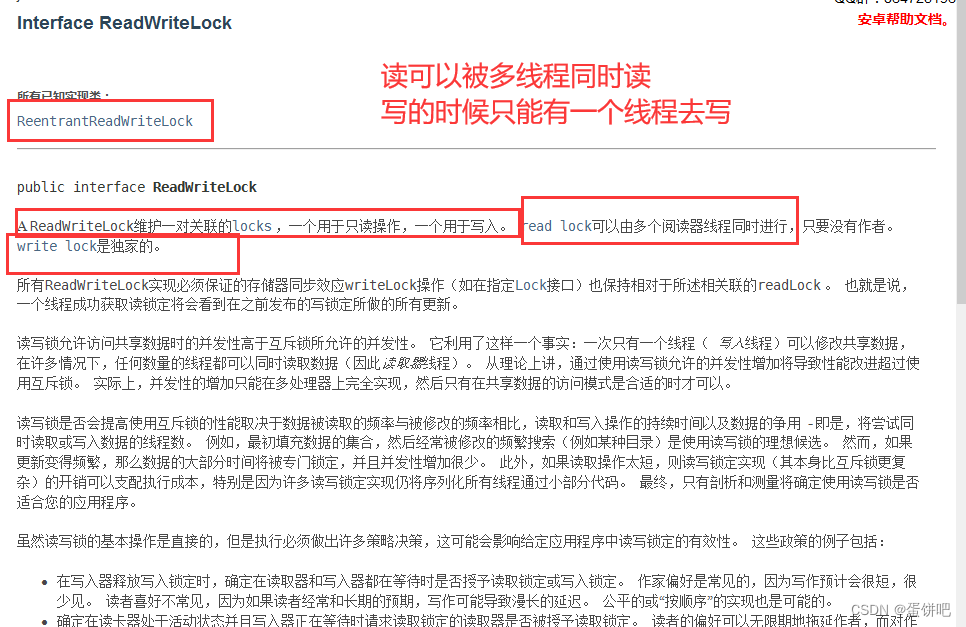
import java.util.HashMap;
import java.util.Map;
import java.util.concurrent.locks.Lock;
import java.util.concurrent.locks.ReadWriteLock;
import java.util.concurrent.locks.ReentrantLock;
import java.util.concurrent.locks.ReentrantReadWriteLock;
/**
* 独占锁(写锁) 一次只能被一个线程占有
* 共享锁(读锁) 多个线程可以同时占有
* ReadWriteLock
* 读-读 可以共存!
* 读-写 不能共存!
* 写-写 不能共存!
*/
public class ReadWriteLockDemo {
public static void main(String[] args) {
MyCache myCache = new MyCache();
// 写入
for (int i = 1; i <= 5 ; i++) {
final int temp = i;
new Thread(()->{
myCache.put(temp+"",temp+"");
},String.valueOf(i)).start();
}
// 读取
for (int i = 1; i <= 5 ; i++) {
final int temp = i;
new Thread(()->{
myCache.get(temp+"");
},String.valueOf(i)).start();
}
}
}
// 加锁的
class MyCacheLock{
private volatile Map<String,Object> map = new HashMap<>();
// 读写锁: 更加细粒度的控制
private ReadWriteLock readWriteLock = new ReentrantReadWriteLock();
private Lock lock = new ReentrantLock();
// 存,写入的时候,只希望同时只有一个线程写
public void put(String key,Object value){
readWriteLock.writeLock().lock();
try {
System.out.println(Thread.currentThread().getName()+"写入"+key);
map.put(key,value);
System.out.println(Thread.currentThread().getName()+"写入OK");
} catch (Exception e) {
e.printStackTrace();
} finally {
readWriteLock.writeLock().unlock();
}
}
// 取,读,所有人都可以读!
public void get(String key){
readWriteLock.readLock().lock();
try {
System.out.println(Thread.currentThread().getName()+"读取"+key);
Object o = map.get(key);
System.out.println(Thread.currentThread().getName()+"读取OK");
} catch (Exception e) {
e.printStackTrace();
} finally {
readWriteLock.readLock().unlock();
}
}
}
/**
* 自定义缓存
*/
class MyCache{
private volatile Map<String,Object> map = new HashMap<>();
// 存,写
public void put(String key,Object value){
System.out.println(Thread.currentThread().getName()+"写入"+key);
map.put(key,value);
System.out.println(Thread.currentThread().getName()+"写入OK");
}
// 取,读
public void get(String key){
System.out.println(Thread.currentThread().getName()+"读取"+key);
Object o = map.get(key);
System.out.println(Thread.currentThread().getName()+"读取OK");
}
}
十、阻塞队列

阻塞队列:


BlockingQueue不是新的东西
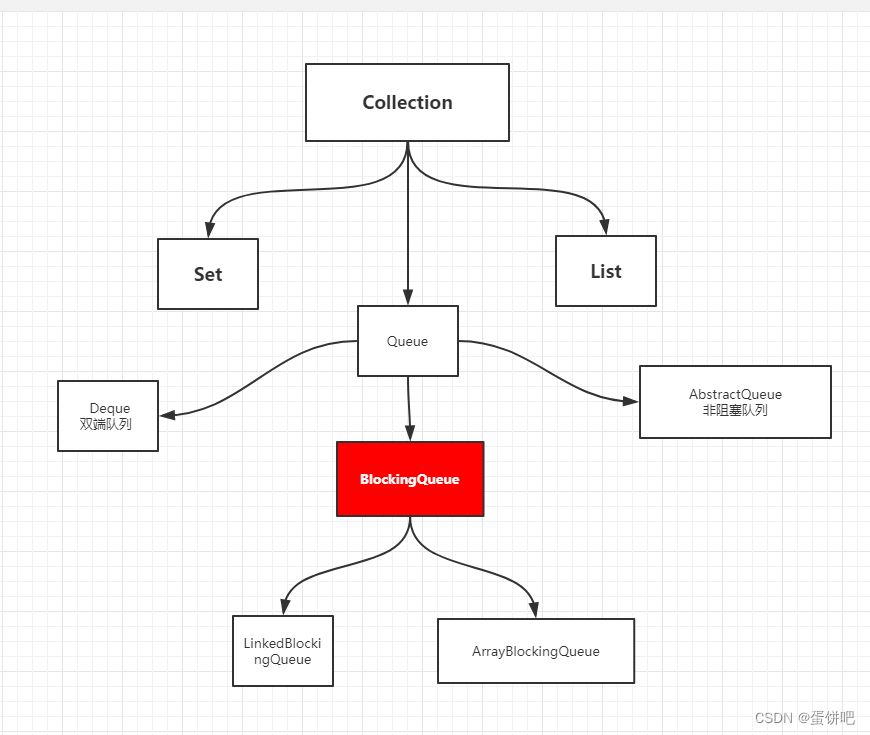
什么情况下我们会使用 阻塞队列:多线程并发处理,线程池!
四组API
| 方式 | 抛出异常 | 有返回值,不抛出异常 | 阻塞 等待 | 超时等待 |
| 添加 | add | offer() | put() | offer(,,) |
| 移除 | remove | poll() | take() | poll(,) |
| 检测队首元素 | element | peek | - | - |
/**
* 抛出异常
*/
public static void test1() {
// 队列的大小
ArrayBlockingQueue blockingQueue = new ArrayBlockingQueue<>(3);
System.out.println(blockingQueue.add("a"));
System.out.println(blockingQueue.add("b"));
System.out.println(blockingQueue.add("c"));
// IllegalStateException: Queue full 抛出异常!
// System.out.println(blockingQueue.add("d"));
System.out.println("=-===========");
System.out.println(blockingQueue.remove());
System.out.println(blockingQueue.remove());
System.out.println(blockingQueue.remove());
// java.util.NoSuchElementException 抛出异常!
// System.out.println(blockingQueue.remove());
}
/**
* 有返回值,没有异常
*/
public static void test2() {
// 队列的大小
ArrayBlockingQueue blockingQueue = new ArrayBlockingQueue<>(3);
System.out.println(blockingQueue.offer("a"));
System.out.println(blockingQueue.offer("b"));
System.out.println(blockingQueue.offer("c"));
// System.out.println(blockingQueue.offer("d")); // false 不抛出异常!
System.out.println("============================");
System.out.println(blockingQueue.poll());
System.out.println(blockingQueue.poll());
System.out.println(blockingQueue.poll());
System.out.println(blockingQueue.poll()); // null 不抛出异常!
}
/**
* 等待,阻塞(一直阻塞)
*/
public static void test3() throws InterruptedException {
// 队列的大小
ArrayBlockingQueue blockingQueue = new ArrayBlockingQueue<>(3);
// 一直阻塞
blockingQueue.put("a");
blockingQueue.put("b");
blockingQueue.put("c");
// blockingQueue.put("d"); // 队列没有位置了,一直阻塞
System.out.println(blockingQueue.take());
System.out.println(blockingQueue.take());
System.out.println(blockingQueue.take());
System.out.println(blockingQueue.take()); // 没有这个元素,一直阻塞
}
/**
* 等待,阻塞(等待超时)
*/
public static void test4() throws InterruptedException {
// 队列的大小
ArrayBlockingQueue blockingQueue = new ArrayBlockingQueue<>(3);
blockingQueue.offer("a");
blockingQueue.offer("b");
blockingQueue.offer("c");
// blockingQueue.offer("d",2,TimeUnit.SECONDS); // 等待超过2秒就退出
System.out.println("===============");
System.out.println(blockingQueue.poll());
System.out.println(blockingQueue.poll());
System.out.println(blockingQueue.poll());
blockingQueue.poll(2, TimeUnit.SECONDS); // 等待超过2秒就退出
}SynchronousQueue 同步队列
没有容量,进去一个元素,必须等待取出来之后,才能再往里面放一个元素! put、take
import java.sql.Time;
import java.util.concurrent.BlockingQueue;
import java.util.concurrent.SynchronousQueue;
import java.util.concurrent.TimeUnit;
/**
* 同步队列
* 和其他的BlockingQueue 不一样, SynchronousQueue 不存储元素
* put了一个元素,必须从里面先take取出来,否则不能在put进去值!
*/
public class SynchronousQueueDemo {
public static void main(String[] args) {
BlockingQueue<String> blockingQueue = new SynchronousQueue<>(); // 同步队
new Thread(()->{
try {
System.out.println(Thread.currentThread().getName()+" put 1");
blockingQueue.put("1");
System.out.println(Thread.currentThread().getName()+" put 2");
blockingQueue.put("2");
System.out.println(Thread.currentThread().getName()+" put 3");
blockingQueue.put("3");
} catch (InterruptedException e) {
e.printStackTrace();
}
},"T1").start();
new Thread(()->{
try {
TimeUnit.SECONDS.sleep(3);
System.out.println(Thread.currentThread().getName()+"=>"+blockingQueue.take());
TimeUnit.SECONDS.sleep(3);
System.out.println(Thread.currentThread().getName()+"=>"+blockingQueue.take());
TimeUnit.SECONDS.sleep(3);
System.out.println(Thread.currentThread().getName()+"=>"+blockingQueue.take());
} catch (InterruptedException e) {
e.printStackTrace();
}
},"T2").start();
}
}十一、线程池(重点)
线程池:三大方法、7大参数、4种拒绝策略
池化技术
程序的运行,本质:占用系统的资源! 优化资源的使用!=>池化技术
线程池、连接池、内存池、对象池///..... 创建、销毁。十分浪费资源
池化技术:事先准备好一些资源,有人要用,就来我这里拿,用完之后还给我。
线程池的好处:
- 降低资源的消耗
- 提高响应的速度
- 方便管理。
线程复用、可以控制最大并发数、管理线程
线程池:三大方法
- Executors.newSingleThreadExecutor();// 单个线程
- Executors.newFixedThreadPool(5); // 创建一个固定的线程池的大小
- Executors.newCachedThreadPool(); // 可伸缩的,遇强则强,遇弱则弱

import java.util.concurrent.ExecutorService;
import java.util.concurrent.Executors;
// Executors 工具类、3大方法
public class Demo01 {
public static void main(String[] args) {
ExecutorService threadPool = Executors.newSingleThreadExecutor();// 单个线程
// ExecutorService threadPool = Executors.newFixedThreadPool(5); // 创建一个固定的线程池的大小
// ExecutorService threadPool = Executors.newCachedThreadPool(); // 可伸缩的,遇强则强,遇弱则弱
try {
for (int i = 0; i < 100; i++) {
// 使用了线程池之后,使用线程池来创建线程
threadPool.execute(() -> {
System.out.println(Thread.currentThread().getName() + " ok");
});
}
} catch (Exception e) {
e.printStackTrace();
} finally {
// 线程池用完,程序结束,关闭线程池
threadPool.shutdown();
}
}
}7大参数
源码分析
public static ExecutorService newSingleThreadExecutor() {
return new FinalizableDelegatedExecutorService
(new ThreadPoolExecutor(1, 1,
0L, TimeUnit.MILLISECONDS,
new LinkedBlockingQueue<Runnable>()));
}
public static ExecutorService newFixedThreadPool(int nThreads) {
return new ThreadPoolExecutor(5, 5,
0L, TimeUnit.MILLISECONDS,
new LinkedBlockingQueue<Runnable>());
}
public static ExecutorService newCachedThreadPool() {
return new ThreadPoolExecutor(0, Integer.MAX_VALUE,
60L, TimeUnit.SECONDS,
new SynchronousQueue<Runnable>());
}
// 本质ThreadPoolExecutor()
public ThreadPoolExecutor(int corePoolSize, // 核心线程池大小
int maximumPoolSize, // 最大核心线程池大小
long keepAliveTime, // 超时了没有人调用就会释放
TimeUnit unit, // 超时单位
BlockingQueue<Runnable> workQueue, // 阻塞队列
ThreadFactory threadFactory, // 线程工厂:创建线程的,一般不用动
RejectedExecutionHandler handle // 拒绝策略
) {
if (corePoolSize < 0 ||maximumPoolSize <= 0 ||maximumPoolSize < corePoolSize ||keepAliveTime < 0)
throw new IllegalArgumentException();
if (workQueue == null || threadFactory == null || handler == null)
throw new NullPointerException();
this.acc = System.getSecurityManager() == null ?null :AccessController.getContext();
this.corePoolSize = corePoolSize;
this.maximumPoolSize = maximumPoolSize;
this.workQueue = workQueue;
this.keepAliveTime = unit.toNanos(keepAliveTime);
this.threadFactory = threadFactory;
this.handler = handler;
}


手动创建一个线程池
import java.util.concurrent.*;
// Executors 工具类、3大方法
/**
* new ThreadPoolExecutor.AbortPolicy() // 银行满了,还有人进来,不处理这个人的,抛出异
常
* new ThreadPoolExecutor.CallerRunsPolicy() // 哪来的去哪里!
* new ThreadPoolExecutor.DiscardPolicy() //队列满了,丢掉任务,不会抛出异常!
* new ThreadPoolExecutor.DiscardOldestPolicy() //队列满了,尝试去和最早的竞争,也不会
抛出异常!
*/
public class Demo01 {
public static void main(String[] args) {
// 自定义线程池!工作 ThreadPoolExecutor
ExecutorService threadPool = new ThreadPoolExecutor(
2,
5,
3,
TimeUnit.SECONDS,
new LinkedBlockingDeque<>(3),
Executors.defaultThreadFactory(),
new ThreadPoolExecutor.DiscardOldestPolicy()); //队列满了,尝试去和最早的竞争,也不会抛出异常!
try {
// 最大承载:Deque + max
// 超过 RejectedExecutionException
for (int i = 1; i <= 9; i++) {
// 使用了线程池之后,使用线程池来创建线程
threadPool.execute(()->{
System.out.println(Thread.currentThread().getName()+" ok");
});
}
} catch (Exception e) {
e.printStackTrace();
} finally {
// 线程池用完,程序结束,关闭线程池
threadPool.shutdown();
}
}
}4种拒绝策略
- new ThreadPoolExecutor.AbortPolicy() // 银行满了,还有人进来,不处理这个人的,抛出异常
- new ThreadPoolExecutor.CallerRunsPolicy() // 哪来的去哪里!
- new ThreadPoolExecutor.DiscardPolicy() //队列满了,丢掉任务,不会抛出异常!
- new ThreadPoolExecutor.DiscardOldestPolicy() //队列满了,尝试去和最早的竞争,也不会抛出异常!

小结和拓展
池的最大的大小如何去设置!
了解:IO密集型,CPU密集型:(调优)
import java.util.concurrent.*;
public class Demo01 {
public static void main(String[] args) {
// 自定义线程池!工作 ThreadPoolExecutor
// 最大线程到底该如何定义
// 1、CPU 密集型,几核,就是几,可以保持CPu的效率最高!
// 2、IO 密集型 > 判断你程序中十分耗IO的线程,
// 程序 15个大型任务 io十分占用资源!
// 获取CPU的核数
System.out.println(Runtime.getRuntime().availableProcessors());
ExecutorService threadPool = new ThreadPoolExecutor(
2,
Runtime.getRuntime().availableProcessors(),
3,
TimeUnit.SECONDS,
new LinkedBlockingDeque<>(3),
Executors.defaultThreadFactory(),
new ThreadPoolExecutor.DiscardOldestPolicy()); //队列满了,尝试去和最早的竞争,也不会抛出异常!
try {
// 最大承载:Deque + max
// 超过 RejectedExecutionException
for (int i = 1; i <= 9; i++) {
// 使用了线程池之后,使用线程池来创建线程
threadPool.execute(()->{
System.out.println(Thread.currentThread().getName()+" ok");
});
}
} catch (Exception e) {
e.printStackTrace();
} finally {
// 线程池用完,程序结束,关闭线程池
threadPool.shutdown();
}
}
}十二、四大函数式接口(必需掌握)
新时代的程序员:lambda表达式、链式编程、函数式接口、Stream流式计算
函数式接口: 只有一个方法的接口
@FunctionalInterface
public interface Runnable {
public abstract void run();
}
// 泛型、枚举、反射
// lambda表达式、链式编程、函数式接口、Stream流式计算
// 超级多FunctionalInterface
// 简化编程模型,在新版本的框架底层大量应用!
// foreach(消费者类的函数式接口) 
Function函数式接口

import java.util.function.Function;
/**
* Function 函数型接口, 有一个输入参数,有一个输出
* 只要是 函数型接口 可以 用 lambda表达式简化
*/
public class Demo01 {
public static void main(String[] args) {
//
// Function<String,String> function = new Function<String,String>() {
// @Override
// public String apply(String str) {
// return str;
// }
// };
Function<String,String> function = (str)->{return str;};
System.out.println(function.apply("asd"));
}
}断定型接口:有一个输入参数,返回值只能是 布尔值!

import java.util.function.Predicate;
/**
* 断定型接口:有一个输入参数,返回值只能是 布尔值!
*/
public class Demo02 {
public static void main(String[] args) {
// 判断字符串是否为空
// Predicate<String> predicate = new Predicate<String>(){
@Override
public boolean test(String str) {
return str.isEmpty();
}
};
Predicate<String> predicate = (str)->{return str.isEmpty(); };
System.out.println(predicate.test(""));
}
}Consumer 消费型接口

import java.util.function.Consumer;
/**
* Consumer 消费型接口: 只有输入,没有返回值
*/
public class Demo03 {
public static void main(String[] args) {
// Consumer<String> consumer = new Consumer<String>() {
// @Override
// public void accept(String str) {
// System.out.println(str);
// }
// };
Consumer<String> consumer = (str)->{System.out.println(str);};
consumer.accept("sdadasd");
}
}Supplier 供给型接口

import java.util.function.Supplier;
/**
* Supplier 供给型接口 没有参数,只有返回值
*/
public class Demo04 {
public static void main(String[] args) {
// Supplier supplier = new Supplier<Integer>() {
// @Override
// public Integer get() {
// System.out.println("get()");
// return 1024;
// }
// };
Supplier supplier = ()->{ return 1024; };
System.out.println(supplier.get());
}
}十三、Stream流式计算
什么是Stream流式计算
大数据:存储 + 计算
集合、MySQL 本质就是存储东西的;
计算都应该交给流来操作!

import java.util.Arrays;
import java.util.List;
/**
* 题目要求:一分钟内完成此题,只能用一行代码实现!
* 现在有5个用户!筛选:
* 1、ID 必须是偶数
* 2、年龄必须大于23岁
* 3、用户名转为大写字母
* 4、用户名字母倒着排序
* 5、只输出一个用户!
*/
public class Test {
public static void main(String[] args) {
User u1 = new User(1,"a",21);
User u2 = new User(2,"b",22);
User u3 = new User(3,"c",23);
User u4 = new User(4,"d",24);
User u5 = new User(6,"e",25);
// 集合就是存储
List<User> list = Arrays.asList(u1, u2, u3, u4, u5);
// 计算交给Stream流
// lambda表达式、链式编程、函数式接口、Stream流式计算
list.stream()
.filter(u->{return u.getId()%2==0;})
.filter(u->{return u.getAge()>23;})
.map(u->{return u.getName().toUpperCase();})
.sorted((uu1,uu2)->{return uu2.compareTo(uu1);})
.limit(1)
.forEach(System.out::println);
}
}十四、ForkJoin
什么是 ForkJoin
ForkJoin 在 JDK 1.7 , 并行执行任务!提高效率。大数据量!
大数据:Map Reduce (把大任务拆分为小任务)
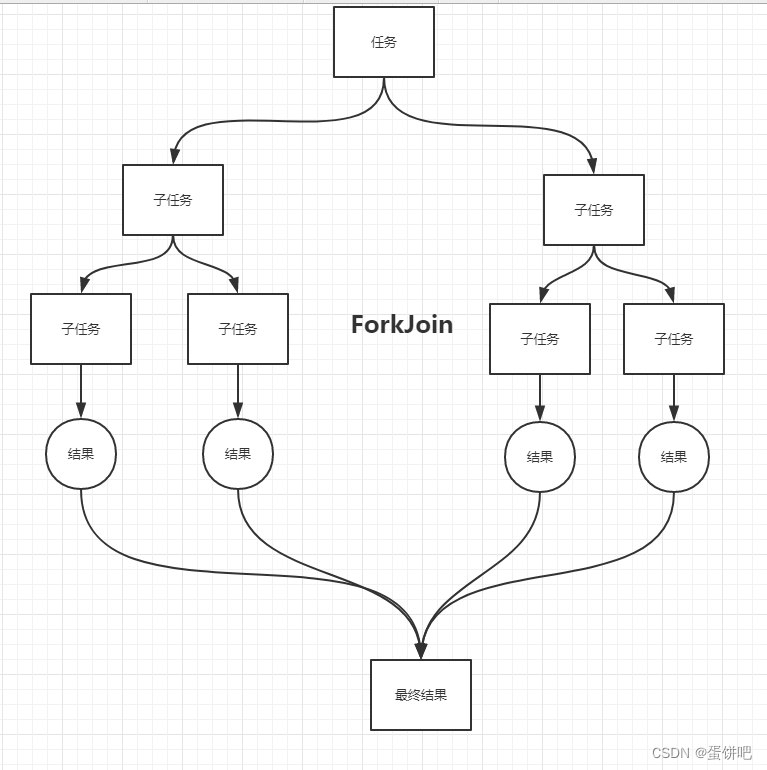
ForkJoin 特点:工作窃取
这个里面维护的都是双端队列
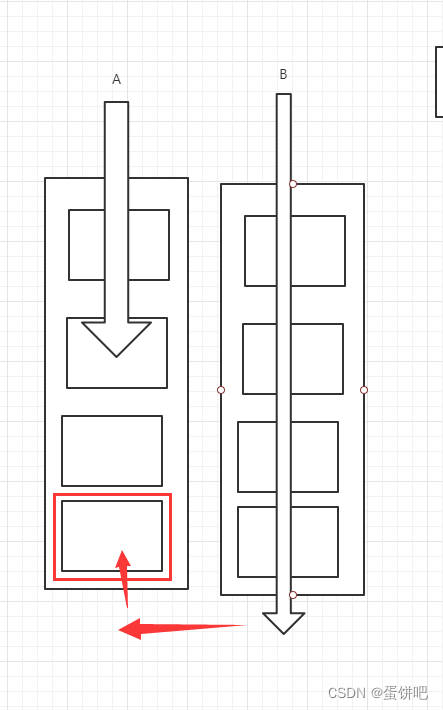
ForkJoin

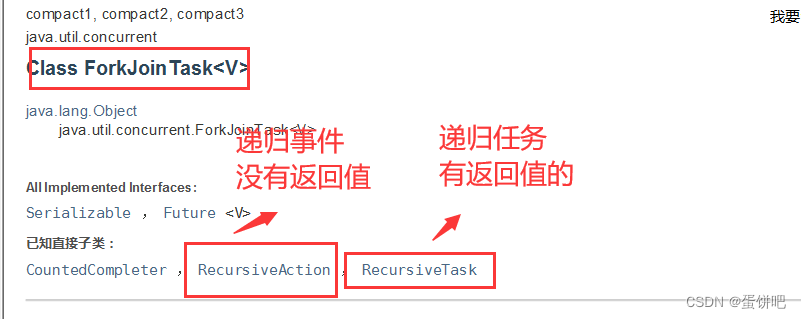
import java.util.concurrent.RecursiveTask;
/**
* 求和计算的任务!
* 3000 6000(ForkJoin) 9000(Stream并行流)
* // 如何使用 forkjoin
* // 1、forkjoinPool 通过它来执行
* // 2、计算任务 forkjoinPool.execute(ForkJoinTask task)
* // 3. 计算类要继承 ForkJoinTask
*/
public class ForkJoinDemo extends RecursiveTask<Long> {
private Long start; // 1
private Long end; // 1990900000
// 临界值
private Long temp = 10000L;
public ForkJoinDemo(Long start, Long end) {
this.start = start;
this.end = end;
}
// 计算方法
@Override
protected Long compute() {
if ((end-start)<temp){
Long sum = 0L;
for (Long i = start; i <= end; i++) {
sum += i;
}
return sum;
}else { // forkjoin 递归
long middle = (start + end) / 2; // 中间值
ForkJoinDemo task1 = new ForkJoinDemo(start, middle);
task1.fork(); // 拆分任务,把任务压入线程队列
ForkJoinDemo task2 = new ForkJoinDemo(middle+1, end);
task2.fork(); // 拆分任务,把任务压入线程队列
return task1.join() + task2.join();
}
}
}测试:
普通-ForkJoin-Stream并行流
import java.util.concurrent.ExecutionException;
import java.util.concurrent.ForkJoinPool;
import java.util.concurrent.ForkJoinTask;
import java.util.stream.DoubleStream;
import java.util.stream.IntStream;
import java.util.stream.LongStream;
/**
* 同一个任务,别人效率高你几十倍!
*/
public class Test {
public static void main(String[] args) throws ExecutionException,
InterruptedException {
// test1(); // 12224
// test2(); // 10038
// test3(); // 153
}
// 普通程序员
public static void test1(){
Long sum = 0L;
long start = System.currentTimeMillis();
for (Long i = 1L; i <= 10_0000_0000; i++) {
sum += i;
}
long end = System.currentTimeMillis();
System.out.println("sum="+sum+" 时间:"+(end-start));
}
// 会使用ForkJoin
public static void test2() throws ExecutionException, InterruptedException {
long start = System.currentTimeMillis();
ForkJoinPool forkJoinPool = new ForkJoinPool();
ForkJoinTask<Long> task = new ForkJoinDemo(0L, 10_0000_0000L);
ForkJoinTask<Long> submit = forkJoinPool.submit(task);// 提交任务
Long sum = submit.get();
long end = System.currentTimeMillis();
System.out.println("sum="+sum+" 时间:"+(end-start));
}
public static void test3(){
long start = System.currentTimeMillis();
// Stream并行流 () (]
long sum = LongStream.rangeClosed(0L,10_0000_0000L).parallel().reduce(0, Long::sum);
long end = System.currentTimeMillis();
System.out.println("sum="+"时间:"+(end-start));
}
}十五、异步回调
Future 设计的初衷: 对将来的某个事件的结果进行建模

可以看另一篇博客说得比较详细:【谷粒商城之CompletableFuture异步编排】_异步编排 谷粒商城_蛋饼吧的博客-CSDN博客
import java.util.concurrent.CompletableFuture;
import java.util.concurrent.ExecutionException;
import java.util.concurrent.Future;
import java.util.concurrent.TimeUnit;
/**
* 异步调用: CompletableFuture
* // 异步执行
* // 成功回调
* // 失败回调
*/
public class Demo01 {
public static void main(String[] args) throws ExecutionException,
InterruptedException {
// 没有返回值的 runAsync 异步回调
// CompletableFuture<Void> completableFuture =
CompletableFuture.runAsync(()->{
// try {
// TimeUnit.SECONDS.sleep(2);
// } catch (InterruptedException e) {
// e.printStackTrace();
// }
//
System.out.println(Thread.currentThread().getName()+"runAsync=>Void");
// });
//
// System.out.println("1111");
//
// completableFuture.get(); // 获取阻塞执行结果
// 有返回值的 supplyAsync 异步回调
// ajax,成功和失败的回调
// 返回的是错误信息;
CompletableFuture<Integer> completableFuture =
CompletableFuture.supplyAsync(()->{
System.out.println(Thread.currentThread().getName()+"supplyAsync=>Integer");
int i = 10/0;
return 1024;
});
System.out.println(completableFuture.whenComplete((t, u) -> {
System.out.println("t=>" + t); // 正常的返回结果
System.out.println("u=>" + u);
// 错误信息:java.util.concurrent.CompletionException: java.lang.ArithmeticException: / byzero
}).exceptionally((e) -> {
System.out.println(e.getMessage());
return 233; // 可以获取到错误的返回结果
}).get());
/**
* succee Code 200
* error Code 404 500
*/
}
}
}十六、JMM
请你谈谈你对 Volatile 的理解
Volatile 是 Java 虚拟机提供轻量级的同步机制
- 保证可见性
- 不保证原子性
- 禁止指令重排
什么是JMM
JMM : Java内存模型,不存在的东西,概念!约定!
关于JMM的一些同步的约定:
- 线程解锁前,必须把共享变量立刻刷回主存。
- 线程加锁前,必须读取主存中的最新值到工作内存中!
- 加锁和解锁是同一把锁
线程 工作内存 、主内存
8种操作:

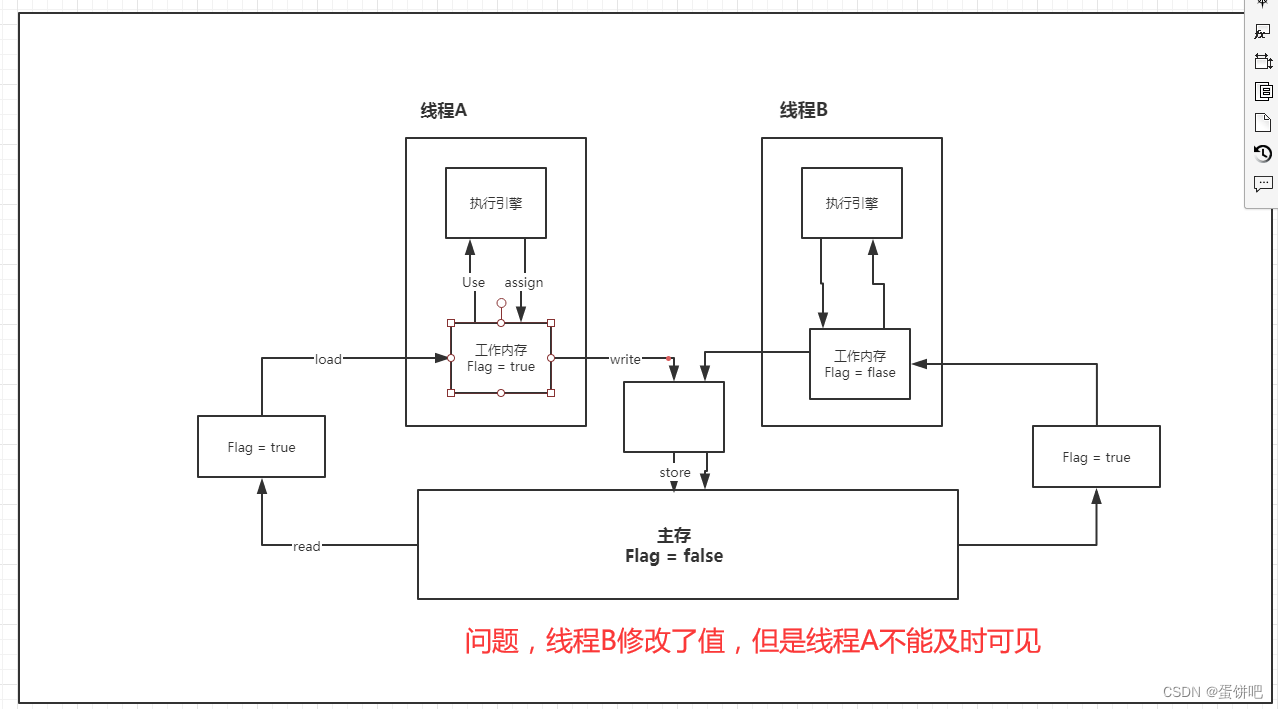
内存交互操作有8种,虚拟机实现必须保证每一个操作都是原子的,不可在分的(对于double和long类型的变量来说,load、store、read和write操作在某些平台上允许例外)
- lock (锁定):作用于主内存的变量,把一个变量标识为线程独占状态
- unlock (解锁):作用于主内存的变量,它把一个处于锁定状态的变量释放出来,释放后的变量
- 才可以被其他线程锁定
- read (读取):作用于主内存变量,它把一个变量的值从主内存传输到线程的工作内存中,以便
- 随后的load动作使用
- load (载入):作用于工作内存的变量,它把read操作从主存中变量放入工作内存中
- use (使用):作用于工作内存中的变量,它把工作内存中的变量传输给执行引擎,每当虚拟机
- 遇到一个需要使用到变量的值,就会使用到这个指令
- assign (赋值):作用于工作内存中的变量,它把一个从执行引擎中接受到的值放入工作内存的变量副本中
- store (存储):作用于主内存中的变量,它把一个从工作内存中一个变量的值传送到主内存中,
- 以便后续的write使用
- write (写入):作用于主内存中的变量,它把store操作从工作内存中得到的变量的值放入主内
- 存的变量中
JMM对这八种指令的使用,制定了如下规则:
- 不允许read和load、store和write操作之一单独出现。即使用了read必须load,使用了store必须write
- 不允许线程丢弃他最近的assign操作,即工作变量的数据改变了之后,必须告知主存
- 不允许一个线程将没有assign的数据从工作内存同步回主内存
- 一个新的变量必须在主内存中诞生,不允许工作内存直接使用一个未被初始化的变量。就是怼变量实施use、store操作之前,必须经过assign和load操作
- 一个变量同一时间只有一个线程能对其进行lock。多次lock后,必须执行相同次数的unlock才能解锁
- 如果对一个变量进行lock操作,会清空所有工作内存中此变量的值,在执行引擎使用这个变量前,必须重新load或assign操作初始化变量的值
- 如果一个变量没有被lock,就不能对其进行unlock操作。也不能unlock一个被其他线程锁住的变量
- 对一个变量进行unlock操作之前,必须把此变量同步回主内存
问题: 程序不知道主内存的值已经被修改过了 (可以使用Volatile来解决)

十七、Volatile
1、保证可见性
import java.util.concurrent.TimeUnit;
public class JMMDemo {
// 不加 volatile 程序就会死循环!
// 加 volatile 可以保证可见性
private volatile static int num = 0;
public static void main(String[] args) { // main
new Thread(()->{ // 线程 1 对主内存的变化不知道的
while (num==0){
}
}).start();
try {
TimeUnit.SECONDS.sleep(1);
} catch (InterruptedException e) {
e.printStackTrace();
}
num = 1;
System.out.println(num);
}
}2、不保证原子性
原子性 : 不可分割
线程A在执行任务的时候,不能被打扰的,也不能被分割。要么同时成功,要么同时失败。
// volatile 不保证原子性
public class VDemo02 {
// volatile 不保证原子性
private volatile static int num = 0;
public static void add() {
num++;
}
public static void main(String[] args) {
//理论上num结果应该为 2 万
for (int i = 1; i <= 20; i++) {
new Thread(() -> {
for (int j = 0; j < 1000; j++) {
add();
}
}).start();
}
while (Thread.activeCount() > 2) { // main gc
Thread.yield();
}
System.out.println(Thread.currentThread().getName() + " " + num);
}
}如果不加 lock 和 synchronized ,怎么样保证原子性

使用原子类,解决 原子性问题

import java.util.concurrent.atomic.AtomicInteger;
// volatile 不保证原子性
public class VDemo02 {
// volatile 不保证原子性
// 原子类的 Integer
private volatile static AtomicInteger num = new AtomicInteger();
public static void add(){
// num++; // 不是一个原子性操作
num.getAndIncrement(); // AtomicInteger + 1 方法, CAS
}
public static void main(String[] args) {
//理论上num结果应该为 2 万
for (int i = 1; i <= 20; i++) {
new Thread(()->{
for (int j = 0; j < 1000 ; j++) {
add();
}
}).start();
}
while (Thread.activeCount()>2){ // main gc
Thread.yield();
}
System.out.println(Thread.currentThread().getName() + " " + num);
}
}这些类的底层都直接和操作系统挂钩!在内存中修改值!Unsafe类是一个很特殊的存在!
指令重排
什么是 指令重排:你写的程序,计算机并不是按照你写的那样去执行的。
源代码-->编译器优化的重排--> 指令并行也可能会重排--> 内存系统也会重排---> 执行
处理器在进行指令重排的时候,考虑:数据之间的依赖性!
int x = 1; // 1
int y = 2; // 2
x = x + 5; // 3
y = x * x; // 4
我们所期望的:1234 但是可能执行的时候回变成 2134 1324
可不可能是 4123!


非计算机专业
volatile可以避免指令重排:
内存屏障。CPU指令。作用:
1、保证特定的操作的执行顺序!
2、可以保证某些变量的内存可见性 (利用这些特性volatile实现了可见性)

Volatile 是可以保持 可见性。不能保证原子性,由于内存屏障,可以保证避免指令重排的现象产生!
十八、彻底玩转单例模式
饿汉式 DCL懒汉式,深究!
饿汉式
// 饿汉式单例
public class Hungry {
// 可能会浪费空间
private byte[] data1 = new byte[1024*1024];
private byte[] data2 = new byte[1024*1024];
private byte[] data3 = new byte[1024*1024];
private byte[] data4 = new byte[1024*1024];
private Hungry(){
}
private final static Hungry HUNGRY = new Hungry();
public static Hungry getInstance(){
return HUNGRY;
}
}DCL 懒汉式
import com.sun.corba.se.impl.orbutil.CorbaResourceUtil;
import java.lang.reflect.Constructor;
import java.lang.reflect.Field;
// 懒汉式单例
// 道高一尺,魔高一丈!
public class LazyMan {
private static boolean qinjiang = false;
private LazyMan(){
synchronized (LazyMan.class){
if (qinjiang == false){
qinjiang = true;
}else {
throw new RuntimeException("不要试图使用反射破坏异常");
}
}
}
private volatile static LazyMan lazyMan;
// 双重检测锁模式的 懒汉式单例 DCL懒汉式
public static LazyMan getInstance(){
if (lazyMan==null){
synchronized (LazyMan.class){
if (lazyMan==null){
lazyMan = new LazyMan(); // 不是一个原子性操作
}
}
}
return lazyMan;
}
// 反射!
public static void main(String[] args) throws Exception {
// LazyMan instance = LazyMan.getInstance();
Field qinjiang = LazyMan.class.getDeclaredField("qinjiang");
qinjiang.setAccessible(true);
Constructor<LazyMan> declaredConstructor =
LazyMan.class.getDeclaredConstructor(null);
declaredConstructor.setAccessible(true);
LazyMan instance = declaredConstructor.newInstance();
qinjiang.set(instance,false);
LazyMan instance2 = declaredConstructor.newInstance();
System.out.println(instance);
System.out.println(instance2);
}
}
/**
* 1. 分配内存空间
* 2、执行构造方法,初始化对象
* 3、把这个对象指向这个空间
*
* 123
* 132 A
* B // 此时lazyMan还没有完成构造
*/静态内部类
// 静态内部类
public class Holder {
private Holder(){
}
public static Holder getInstace(){
return InnerClass.HOLDER;
}
public static class InnerClass{
private static final Holder HOLDER = new Holder();
}
}单例不安全,反射
枚举
import java.lang.reflect.Constructor;
import java.lang.reflect.InvocationTargetException;
// enum 是一个什么? 本身也是一个Class类
public enum EnumSingle {
INSTANCE;
public EnumSingle getInstance(){
return INSTANCE;
}
}
class Test{
public static void main(String[] args) throws NoSuchMethodException,
IllegalAccessException, InvocationTargetException, InstantiationException {
EnumSingle instance1 = EnumSingle.INSTANCE;
Constructor<EnumSingle> declaredConstructor =
EnumSingle.class.getDeclaredConstructor(String.class,int.class);
declaredConstructor.setAccessible(true);
EnumSingle instance2 = declaredConstructor.newInstance();
// NoSuchMethodException: com.kuang.single.EnumSingle.<init>()
System.out.println(instance1);
System.out.println(instance2);
}
}
枚举类型的最终反编译源码:
// Decompiled by Jad v1.5.8g. Copyright 2001 Pavel Kouznetsov.
// Jad home page: http://www.kpdus.com/jad.html
// Decompiler options: packimports(3)
// Source File Name: EnumSingle.java
package com.kuang.single;
public final class EnumSingle extends Enum
{
public static EnumSingle[] values()
{
return (EnumSingle[])$VALUES.clone();
}
public static EnumSingle valueOf(String name)
{
return (EnumSingle)Enum.valueOf(com/kuang/single/EnumSingle, name);
}
private EnumSingle(String s, int i)
{
super(s, i);
}
public EnumSingle getInstance()
{
return INSTANCE;
}
public static final EnumSingle INSTANCE;
private static final EnumSingle $VALUES[];
static
{
INSTANCE = new EnumSingle("INSTANCE", 0);
$VALUES = (new EnumSingle[] {
INSTANCE
});
}
}十九、深入理解CAS
什么是 CAS
CAS是compare and swap的缩写,即我们所说的比较交换。cas是一种基于锁的操作,而且是乐观锁。在java中锁分为乐观锁和悲观锁。悲观锁是将资源锁住,等一个之前获得锁的线程释放锁之后,下一个线程才可以访问。而乐观锁采取了一种宽泛的态度,通过某种方式不加锁来处理资源,比如通过给记录加version来获取数据,性能较悲观锁有很大的提高。
import java.util.concurrent.atomic.AtomicInteger;
public class CASDemo {
// CAS compareAndSet : 比较并交换!
public static void main(String[] args) {
AtomicInteger atomicInteger = new AtomicInteger(2020);
// 期望、更新
// public final boolean compareAndSet(int expect, int update)
// 如果我期望的值达到了,那么就更新,否则,就不更新, CAS 是CPU的并发原语!
System.out.println(atomicInteger.compareAndSet(2020, 2021));
System.out.println(atomicInteger.get());
atomicInteger.getAndIncrement()
System.out.println(atomicInteger.compareAndSet(2020, 2021));
System.out.println(atomicInteger.get());
}
}Unsafe 类
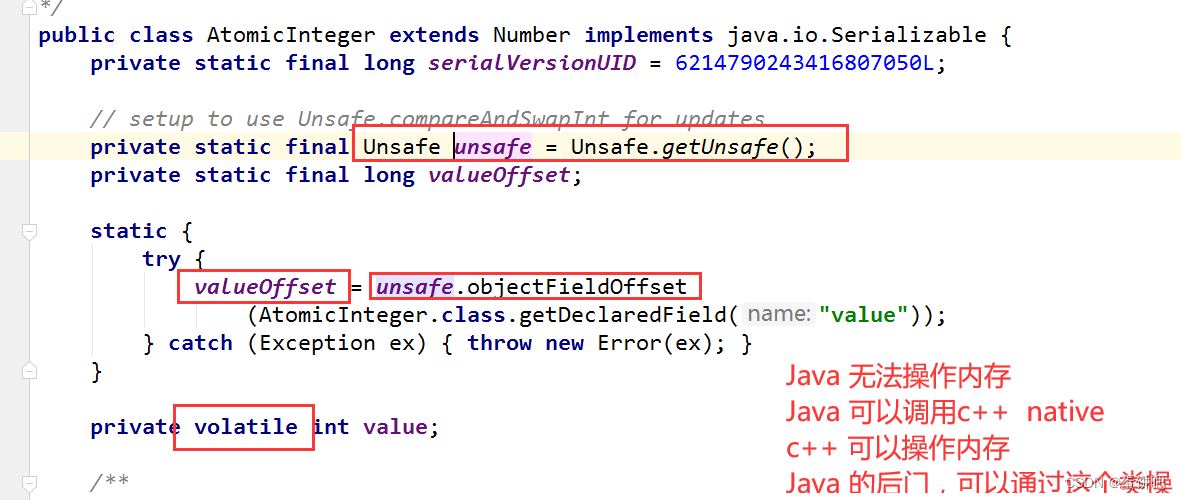
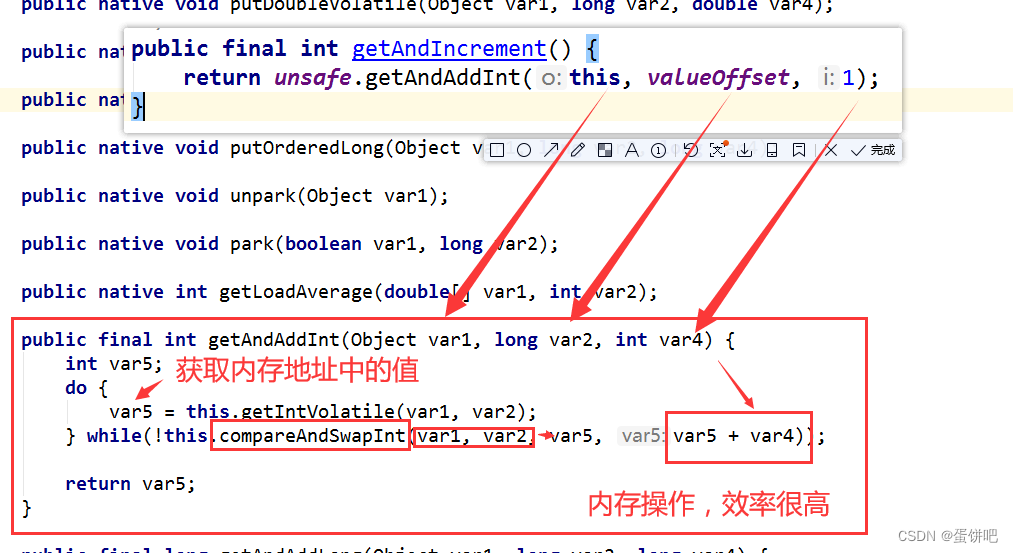

CAS : 比较当前工作内存中的值和主内存中的值,如果这个值是期望的,那么则执行操作!如果不是就一直循环!
缺点:
- 循环会耗时
- 一次性只能保证一个共享变量的原子性
- ABA问题
CAS : ABA 问题(狸猫换太子)
解决方法见下面的原子引用

import java.util.concurrent.atomic.AtomicInteger;
public class CASDemo {
// CAS compareAndSet : 比较并交换!
public static void main(String[] args) {
AtomicInteger atomicInteger = new AtomicInteger(2020);
// 期望、更新
// public final boolean compareAndSet(int expect, int update)
// 如果我期望的值达到了,那么就更新,否则,就不更新, CAS 是CPU的并发原语!
// ============== 捣乱的线程 ==================
System.out.println(atomicInteger.compareAndSet(2020, 2021));
System.out.println(atomicInteger.get());
System.out.println(atomicInteger.compareAndSet(2021, 2020));
System.out.println(atomicInteger.get());
// ============== 期望的线程 ==================
System.out.println(atomicInteger.compareAndSet(2020, 6666));
System.out.println(atomicInteger.get());
}
}二十、原子引用
解决ABA 问题,引入原子引用! 对应的思想:乐观锁!
带版本号的原子操作!AtomicStampedReference
这里使用的是AtomicStampedReference的compareAndSet函数,这里面有四个参数:
compareAndSet(V expectedReference, V newReference, int expectedStamp, int newStamp)。
(1)第一个参数expectedReference:表示预期值。
(2)第二个参数newReference:表示要更新的值。
(3)第三个参数expectedStamp:表示预期的时间戳。
(4)第四个参数newStamp:表示要更新的时间戳。
import java.util.concurrent.TimeUnit;
import java.util.concurrent.atomic.AtomicStampedReference;
public class CASDemo {
//AtomicStampedReference 注意,如果泛型是一个包装类,注意对象的引用问题
// 正常在业务操作,这里面比较的都是一个个对象
static AtomicStampedReference<Integer> atomicStampedReference = new
AtomicStampedReference<>(1, 1);
// CAS compareAndSet : 比较并交换!
public static void main(String[] args) {
new Thread(() -> {
int stamp = atomicStampedReference.getStamp(); // 获得版本号
System.out.println("a1=>" + stamp);
try {
TimeUnit.SECONDS.sleep(1);
} catch (InterruptedException e) {
e.printStackTrace();
}
atomicStampedReference.compareAndSet(1, 2,
atomicStampedReference.getStamp(),
atomicStampedReference.getStamp() + 1);
System.out.println("a2=>" + atomicStampedReference.getStamp());
System.out.println(atomicStampedReference.compareAndSet(2, 1,
atomicStampedReference.getStamp(),
atomicStampedReference.getStamp() + 1));
System.out.println("a3=>" + atomicStampedReference.getStamp());
}, "a").start();
// 乐观锁的原理相同!
new Thread(() -> {
int stamp = atomicStampedReference.getStamp(); // 获得版本号
System.out.println("b1=>" + stamp);
try {
TimeUnit.SECONDS.sleep(2);
} catch (InterruptedException e) {
e.printStackTrace();
}
System.out.println(atomicStampedReference.compareAndSet(1, 6,
stamp, stamp + 1));
System.out.println("b2=>" + atomicStampedReference.getStamp());
}, "b").start();
}
}注意:Integer 使用了对象缓存机制,默认范围是 -128 ~ 127 ,推荐使用静态工厂方法 valueOf 获取对象实例,而不是 new,因为 valueOf 使用缓存,而 new 一定会创建新的对象分配新的内存空间

二十一、各种锁的理解
1、公平锁、非公平锁
公平锁: 非常公平, 不能够插队,必须先来后到!
非公平锁:非常不公平,可以插队 (默认都是非公平)
public ReentrantLock() {
sync = new NonfairSync();
}
public ReentrantLock(boolean fair) {
sync = fair ? new FairSync() : new NonfairSync();
}2、可重入锁
可重入锁(递归锁)

Synchronized
import javax.sound.midi.Soundbank;
// Synchronized
public class Demo01 {
public static void main(String[] args) {
Phone phone = new Phone();
new Thread(()->{
phone.sms();
},"A").start();
new Thread(()->{
phone.sms();
},"B").start();
}
}
class Phone{
public synchronized void sms(){
System.out.println(Thread.currentThread().getName() + "sms");
call(); // 这里也有锁
}
public synchronized void call(){
System.out.println(Thread.currentThread().getName() + "call");
}
}Lock 版
import java.util.concurrent.locks.Lock;
import java.util.concurrent.locks.ReentrantLock;
public class Demo02 {
public static void main(String[] args) {
Phone2 phone = new Phone2();
new Thread(()->{
phone.sms();
},"A").start();
new Thread(()->{
phone.sms();
},"B").start();
}
}
class Phone2{
Lock lock = new ReentrantLock();
public void sms(){
lock.lock(); // 细节问题:lock.lock(); lock.unlock(); // lock 锁必须配对,否则就会死在里面
lock.lock();
try {
System.out.println(Thread.currentThread().getName() + "sms");
call(); // 这里也有锁
} catch (Exception e) {
e.printStackTrace();
} finally {
lock.unlock();
lock.unlock();
}
}
public void call(){
lock.lock();
try {
System.out.println(Thread.currentThread().getName() + "call");
} catch (Exception e) {
e.printStackTrace();
} finally {
lock.unlock();
}
}
}3、自旋锁
spinlock

我们来自定义一个锁测试
import java.util.concurrent.atomic.AtomicReference;
/**
* 自旋锁
*/
public class SpinlockDemo {
// int 0
// Thread null
AtomicReference<Thread> atomicReference = new AtomicReference<>();
// 加锁
public void myLock(){
Thread thread = Thread.currentThread();
System.out.println(Thread.currentThread().getName() + "==> mylock");
// 自旋锁
while (!atomicReference.compareAndSet(null,thread)){
}
}
// 解锁
// 加锁
public void myUnLock(){
Thread thread = Thread.currentThread();
System.out.println(Thread.currentThread().getName() + "==> myUnlock");
atomicReference.compareAndSet(thread,null);
}
}测试
import java.util.concurrent.TimeUnit;
import java.util.concurrent.locks.ReentrantLock;
public class TestSpinLock {
public static void main(String[] args) throws InterruptedException {
// ReentrantLock reentrantLock = new ReentrantLock();
// reentrantLock.lock();
// reentrantLock.unlock();
// 底层使用的自旋锁CAS
SpinlockDemo lock = new SpinlockDemo();
new Thread(()-> {
lock.myLock();
try {
TimeUnit.SECONDS.sleep(5);
} catch (Exception e) {
e.printStackTrace();
} finally {
lock.myUnLock();
}
},"T1").start();
TimeUnit.SECONDS.sleep(1);
new Thread(()-> {
lock.myLock();
try {
TimeUnit.SECONDS.sleep(1);
} catch (Exception e) {
e.printStackTrace();
} finally {
lock.myUnLock();
}
},"T2").start();
}
}
4、死锁
死锁是什么

死锁测试,怎么排除死锁:
import com.sun.org.apache.xpath.internal.SourceTree;
import java.util.concurrent.TimeUnit;
public class DeadLockDemo {
public static void main(String[] args) {
String lockA = "lockA";
String lockB = "lockB";
new Thread(new MyThread(lockA, lockB), "T1").start();
new Thread(new MyThread(lockB, lockA), "T2").start();
}
}
class MyThread implements Runnable{
private String lockA;
private String lockB;
public MyThread(String lockA, String lockB) {
this.lockA = lockA;
this.lockB = lockB;
}
@Override
public void run() {
synchronized (lockA){
System.out.println(Thread.currentThread().getName() +
"lock:"+lockA+"=>get"+lockB);
try {
TimeUnit.SECONDS.sleep(2);
} catch (InterruptedException e) {
e.printStackTrace();
}
synchronized (lockB){
System.out.println(Thread.currentThread().getName() +
"lock:"+lockB+"=>get"+lockA);
}
}
}
}解决问题
1、使用 jps -l 定位进程号

2、使用 jstack 进程号 找到死锁问题
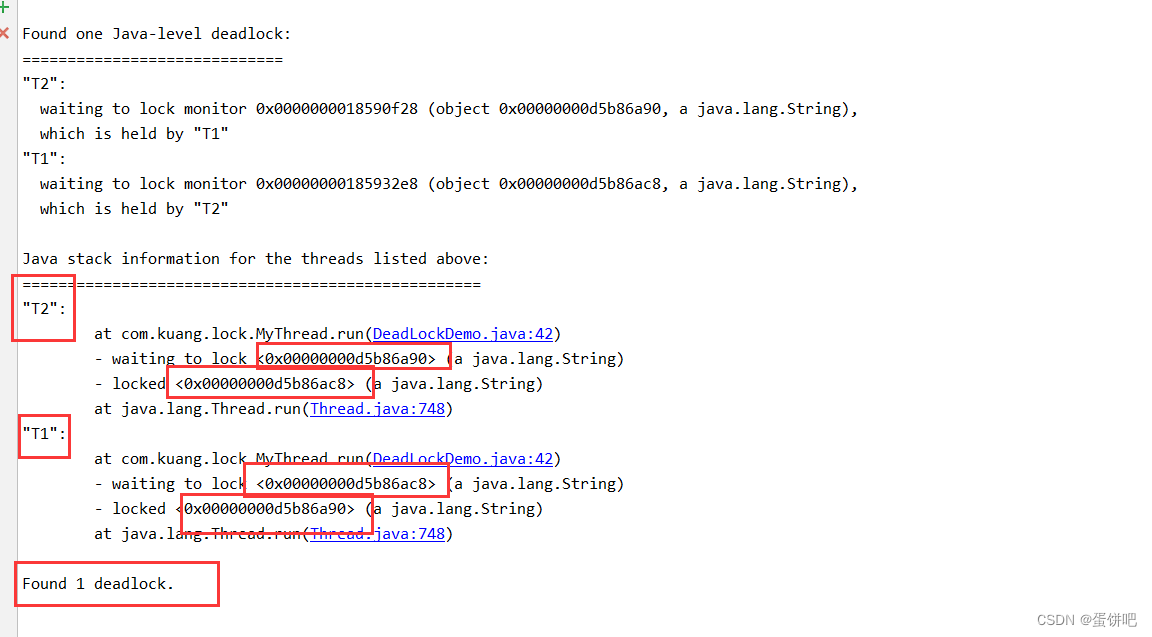
得多练习、多回顾
结束!





















 601
601











 被折叠的 条评论
为什么被折叠?
被折叠的 条评论
为什么被折叠?








